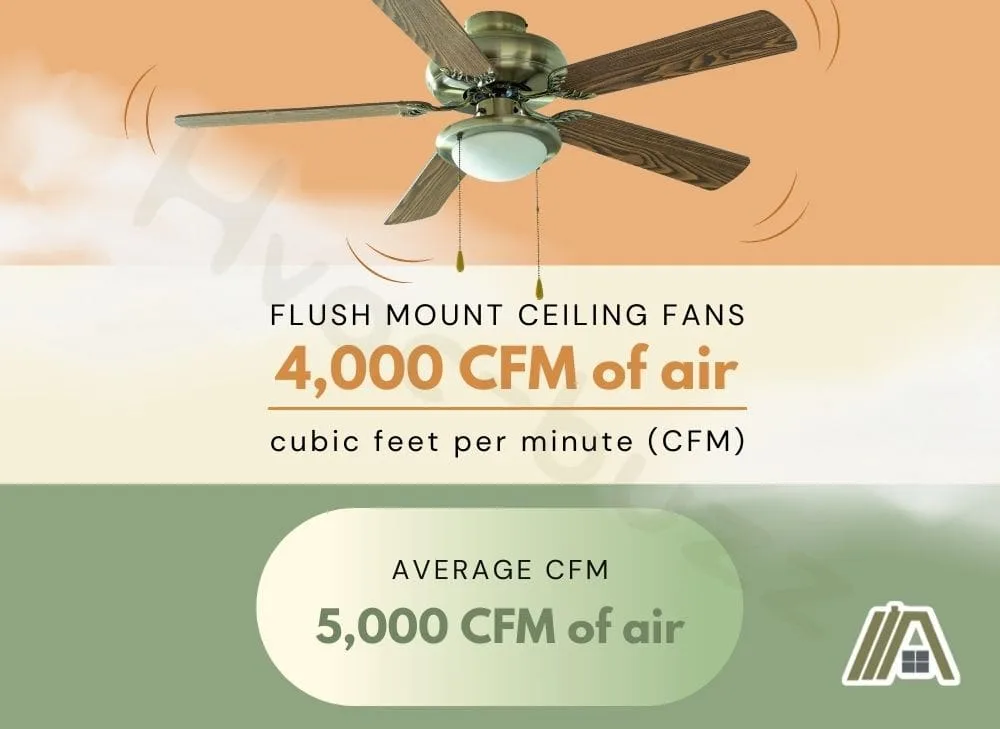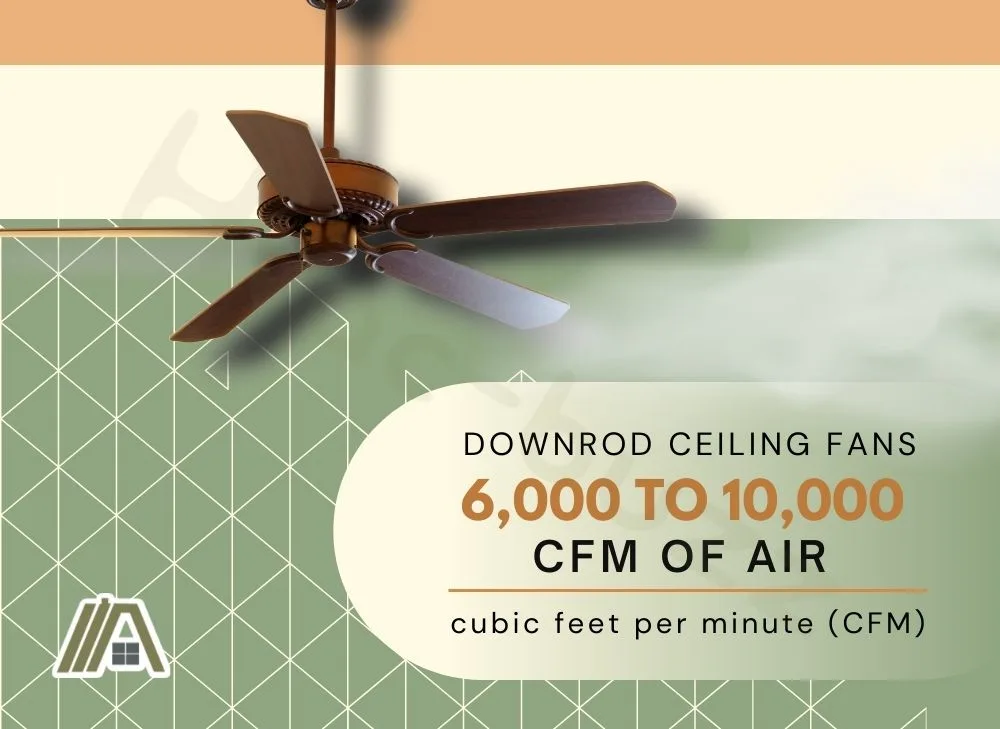
Flush mount ceiling fans are closer to the ceiling, and downrod ceiling fans are suspended further from the ceiling. This makes downrod fans easier to install and maintain and also makes them more effective and efficient, and less noisy.
Difference Between Flush Mount and Downrod Ceiling Fan: Overview
Both a flush mount and a downrod ceiling fan can be controlled in numerous ways, both use blades to move the air, and both can be used in nearly any setting.
The most distinguishing difference between these fans is that the flush mount fan is set up so that the base of the fan is in direct contact with the ceiling. Whereas a downrod ceiling fan is extended away from the ceiling using a rod that can vary in length.
What Is a Flush Mount Ceiling Fan
A flush mount ceiling fan (amazon link) is a fan that is attached directly to the ceiling at its base.
Such fans come in many different sizes, styles, and designs, but they are often adapted for smaller spaces and can look odd in larger rooms.
Flush mount ceiling fans can come with options of lights or no lights.
They can also come with a wall switch control, remote control, pull chain control, or combinations of these controls.
Purchase Price
Flush mount ceiling fans tend to cost less than downrod ceiling fans.
This is because there is less equipment needed with a flush mount ceiling fan, and also because they tend to be smaller to match the spaces in which they are predominantly used.
Of course, this only applies to solely flush mount and downrod fans. Many fans come with the dual installation option and so the price is the same.
Ease of Installation and Maintenance
Flush mount ceiling fans are a little tricky to install, simply because you are working with the fan closer to the ceiling.
So, to connect the wires, you have to fit your hands between the ceiling and the fan. You also have to work with your hands over your head or with your head pressed against the ceiling and your neck at an odd angle.
On the other hand, if the wires are already short, then it would be more difficult to lay new wires or extend the existing ones.
Maintenance can be more difficult.
If you have to tighten screws in the junction box, etc., then you might have to find a shorter screwdriver to fit in the space between the fan body and the ceiling.

Cleaning the blades is going to be a bit more difficult because of how close they are to the ceiling.
You have to make sure that you do not press down hard on the blades or they can come loose and cause the fan to wobble.
Motors in flush mount fans tend to run harder (I’ll explain why in the next section). This can make maintenance more difficult by making it necessary to carry out maintenance more frequently.
Effectiveness and Efficiency
Effectiveness can be defined as how well a ceiling fan moves air around, and efficiency can be defined as how much power is required to produce x amount of air.
Flush mount ceiling fans tend to be the less effective and less efficient installation option.
The less space that exists between the blades of the fan and the ceiling, the more difficult it is for the air to be pushed in a helpful direction.
Instead, the air bounces between the blades and the ceiling, creating turbulence and resulting in energy loss.
To produce x amount of airflow (i.e., air that is flowing in a specific and helpful direction), the fan will have to work longer and harder to overcome the turbulent energy loss. This is what reduces efficiency.
Flush mount ceiling fans tend to move around 4,000 cubic feet per minute (CFM) of air. This is on the lower side but is still not bad. A ceiling fan with a CFM of 5,000 is around average.

This makes sense. Who would continue to produce a ceiling fan that was useless? They’re less effective and efficient, but that does not make them ineffective or inefficient.
Noise Level
Flush mount ceiling fans tend to be louder than downrod ceiling fans.
There are three main reasons for this.
Firstly, the bulk of the noise created by a ceiling fan comes from the motor operating. If the motor is working harder (as it needs to in the case of the flush mount ceiling fan) then it will be louder.
Secondly, motors that are constantly working harder have a higher chance of straining and developing mechanical problems. Both of these have the potential to create even more noise.
In my childhood home, we had a flush mount ceiling fan that always sounded as if it were ready to burst into flames and was actually hot to the touch because of how hard the motor was running.
Thirdly, the turbulent air above the fan is going to lead to noisier operation.
What Is a Downrod Ceiling Fan
Downrod ceiling fans (amazon link) are ceiling fans that use a rod (normally made of metal) to extend the blades and motor away from a ceiling.
Normally, downrods are used on higher ceilings that allow the installation while maintaining proper ceiling fan clearances.
Downrod ceiling fans can come in various designs, styles, and sizes, which allow for customizability.
These fans can also come with a wall switch control, pull chain control, or remote controls. Combinations of these controls are also possible. They can come with or without lights.
Purchase Price
Downrod ceiling fans tend to cost more than flush mount ceiling fans. This is because there is more equipment needed for a downrod ceiling fan and because they are, on average, larger.
However, there is usually very little difference in cost if comparing fans that differ only in the installation mode.
Ease of Installation and Maintenance
Downrod ceiling fans can be difficult to install if the wires feeding the fixture have been cut too short.
You can also struggle to feed the wires through the downrod, particularly if there is a dent or two in a narrow rod.
However, for the most part, it’s a little easier to install downrod fans because there is more room to work and you don’t have to do the fiddly work so close to the ceiling.
In general, maintenance of downrod ceiling fans is easier because the fan isn’t positioned as high.
The motor of a downrod tends not to work as hard, which is a plus in the maintenance department.
Downrod ceiling fans can be installed on sloped ceilings if the downrod is long enough to prevent the blades hitting the lower side on the ceiling.
Effectiveness and Efficiency
Downrod ceiling fans tend to be more effective and more efficient than a flush mount ceiling fan.
By being positioned away from the ceiling, downrod ceiling fans do not have their airflow impeded by the ceiling. This allows them to be more effective at moving air.
This also allows for the downrod ceiling fan to be more efficient. By not having airflow hindered by the ceiling, the motor doesn’t need to work as hard.
Downrod ceiling fans also have a fairly high average CFM, ranging from 6,000 to 10,000 CFM. This wide and high range is due to the various characteristics that are described above.

Noise Level
Downrod ceiling fans tend to be quieter than the flush mount ceiling fans.
This is mostly due to the motor of a downrod ceiling fan not having to work as hard. This also gives the motor less of a chance of significant wear and tear that could create additional sounds.
Table of Differences Between Flush Mount and Downrod Ceiling Fans
| Flush Mount Ceiling Fan | Downrod Ceiling Fan | |
| Distance from ceiling | Close to ceiling | Suspended away from the ceiling with options on the distance |
| Cost | Can cost less | May cost more |
| Installation | More difficult | Easier |
| Maintenance | Tends to be harder to maintenance | Tends to be easier to maintain |
| Effectiveness | Lower | Higher |
| Efficiency | Lower | Higher |
| Noise levels | Typically louder | Typically quieter |
Should I Get a Flush Mount or Downrod Ceiling Fan?
If you are looking at using a fan for a taller or even just a standard-height ceiling, a fan with a downrod is better. If the room has a low ceiling, then a flush mount ceiling fan would be best.
If the height of the ceiling isn’t being considered, then a downrod ceiling fan is probably the best bet. Overall it really is the better installation option for a ceiling fan.
A downrod fan can also be purchased with dual mounting options (amazon link), which allows for the height or mounting to be adjusted if you change your mind after the installation.
Sources
https://applianceanalysts.com/flush-vs-downrod-ceiling-fan/
https://www.neatceiling.com/flush-mount-vs-downrod-ceiling-fan/
https://www.lightology.com/index.php?module=how_to&sub=ceiling_fan_label


